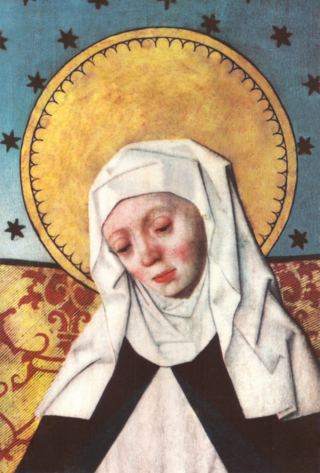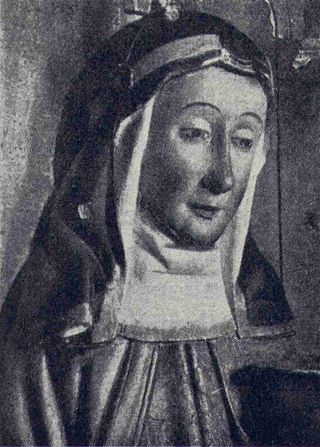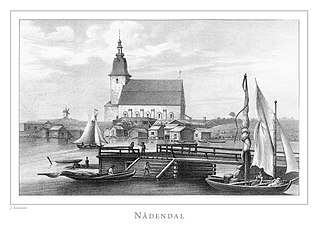
A nun is a woman who vows to dedicate her life to religious service and contemplation, typically living under vows of poverty, chastity, and obedience in the enclosure of a monastery or convent. The term is often used interchangeably with religious sisters who do take simple vows but live an active vocation of prayer and charitable work.

Bridget of Sweden, OSsS born as Birgitta Birgersdotter, also Birgitta of Vadstena, was a Swedish widow, mystic, saint, and the founder of the Bridgettines. Outside Sweden, she was also known as the Princess of Nericia and was the mother of Catherine of Vadstena.

Catherine of Sweden, Katarina av Vadstena, Catherine of Vadstena or Katarina Ulfsdotter was a Swedish noblewoman. She is venerated as a saint in the Roman Catholic Church. Her father was Ulf Gudmarsson, Lord of Ulvåsa, and her mother was Saint Bridget of Sweden.

Syon Abbey, also called simply Syon, was a dual monastery of men and women of the Bridgettine Order, although it only ever had abbesses during its existence. It was founded in 1415 and stood, until its demolition in the 16th century, on the left (northern) bank of the River Thames within the parish of Isleworth, in the county of Middlesex, on or near the site of the present Georgian mansion of Syon House, today in the London Borough of Hounslow. It was named after the biblical holy "City of David which is Zion", built on the eponymous Mount Zion.

A double monastery is a monastery combining separate communities of monks and of nuns, joined in one institution to share one church and other facilities. The practice is believed to have started in the East at the dawn of monasticism. It is considered more common in the monasticism of Eastern Christianity, where it is traceable to the 4th century. In the West the establishment of double monasteries became popular after Columbanus and sprang up in Gaul and in Anglo-Saxon England. Double monasteries were forbidden by the Second Council of Nicaea in 787, though it took many years for the decree to be enforced. Double monasteries were revived again after the 12th century in a significantly different way when a number of religious houses were established on this pattern among Benedictines and possibly the Dominicans. The 14th-century Bridgittines were purposely founded using this form of community.
A canoness is a member of a religious community of women living a simple life. Many communities observe the monastic Rule of St. Augustine. The name corresponds to the male equivalent, a canon, though some women may use the title canon and not canoness similar to the way actor is used rather than actress, e.g. Sarah Foot. The origin and Rule are common to both. As with the canons, there are two types: canonesses regular, who follow the Augustinian Rule, and secular canonesses, who follow no monastic Rule of Life.

The Abbey Pax Mariae, more commonly referred to as Vadstena Abbey, situated on Lake Vättern in the Diocese of Linköping, Sweden, is a monastery of nuns within the Bridgettine Order. It was active from 1346 until 1595 and has been active since 1963, regaining status as an autonomous abbey in 1991.

Stanbrook Abbey is a Catholic contemplative Benedictine Monastery with the status of an abbey, located at Wass, North Yorkshire, England.

Mariager Abbey was a Bridgettine abbey founded in 1430 which became an important pilgrimage site, in the present town of Mariager in northern central Jutland, Denmark.

Maribo Abbey, established in 1416, was the first Bridgettine monastery in Denmark and became one of the most important Danish abbeys of the late Middle Ages. It was located in the present town of Maribo on the island of Lolland in southern Denmark. The monastery is in ruins, but the abbey church still remains in use as Maribo Cathedral.

Santa Brigida is a convent church dedicated to St Bridget of Sweden and the Swedish national church in Rome. It was also known as Santa Brigida a Campo de' Fiori since it was built on what was then part of Campo de' Fiori but is now the urbanistically distinct Piazza Farnese.
Birgitta Botolfsdotter, or Botulfsdotter was a Swedish Roman Catholic nun, abbess of Vadstena Abbey during the ongoing Protestant Reformation.
Ingegerd Knutsdotter was a Swedish nun and noble, the first official abbess of the Bridgettine Abbey of Vadstena in 1385/88–1403.

Nådendal Abbey, was a Bridgettine abbey in then-Swedish Finland, in operation from 1438 to 1591. The abbey was first situated in Masku, secondly in Perniö (1441) and finally in Naantali in 1443. It was one of six monasteries in Finland during the Middle Ages, and, as a double monastery, the only one which accepted women.
Katarina Bengtsdotter Gylta, in Latin: Catharina Benedicta, was a Swedish nun of the Bridgettine Order, Abbess of Vadstena Abbey in 1553–1564 and 1565–1593. She was the second last abbess in Sweden and Vadstena Abbey after the reformation.
Marienbrunn Abbey also called Fons Mariae and Triumphus Marie was a double convent for women and men of the order of the Bridgettines, situated in Gdańsk between 1391 and 1833. It was the first convent of the order founded outside of Sweden, and the second convent of the order altogether.
Karin Johansdotter, was a Swedish Roman Catholic nun of the Bridgettine Order. She was the last nun in Sweden after the Swedish Reformation.
Anna Germundsdotter or Girmundsdotter was a Swedish nun of the Bridgettine order and writer. She served as abbess of Vadstena Abbey from 1518 until 1529.
Katherine Palmer was abbess of Syon Abbey during its peregrination in the Netherlands. She was responsible for preserving the only English religious community to continue unbroken through the Reformation.

















